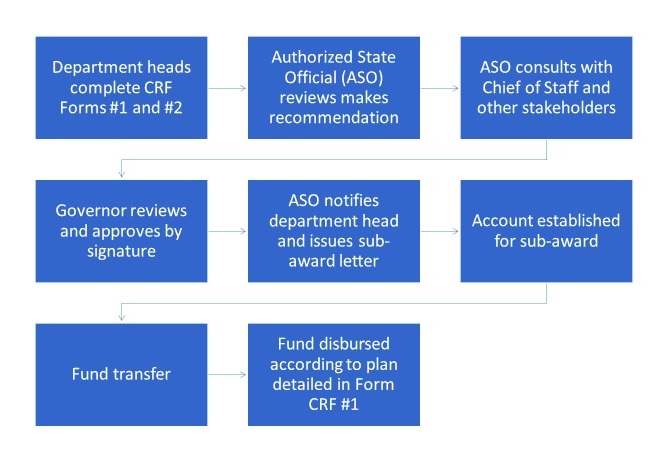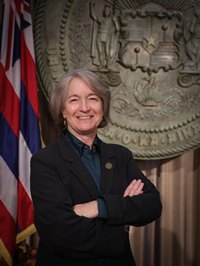CRF Sub-Recipient Guide
The Coronavirus Relief Fund (CRF) was established through the CARES Act as payments to State, Local, and Tribal governments to navigate the impact of the COVID-19 outbreak. Hawaii has received $1.25 billion in CRF funding, with the Office of the Governor and the City and County of Honolulu as “Prime Recipients.” All entities – e.g. state departments and agencies - that receive CRF awards from the Prime Recipients are “Sub-Recipients” of CRF.
This Guide – prepared by the Department of Attorney General and the Department of Budget & Finance - is designed to assist Sub-Recipients of CRF funds allocated to the Office of the Governor in complying with key legal and regulatory requirements associated with the management and use of CRF funds. It explains eligibility and reporting requirements, as well as oversight and accountability framework.
The management of CRF expenditures require careful planning, clear documentation, and detailed accounting and reporting.
Governor: As a Prime Recipient of CRF moneys, Governor Ige develops the overall strategy on how CRF can best be used to help the people of Hawai‘i. In consultation with the Legislature, Governor Ige approves all use of CRF allocations and disbursements. Governor Ige’s top three priorities for the use of CRF are:
- Protect Public Health
- Revive the Economy
- Strengthen the Community
Chief of Staff: Chief of Staff implements Governor Ige’s strategy for use of CRF by directing and coordination action among the departments of the state government.
Authorized State Official (“ASO”): In consultation with the Chief of Staff, the ASO acts on behalf of the Governor to coordinate department level actions and provides support to departments using CRF funds. ASO reviews and recommends to Governor approval of department proposals for use of CRF fund and coordinates the establishment of accounts and the transfer of CRF funds to departments. Robert Yu, Deputy Director of Budget and Finance, has been appointed the Authorized State Official.
Office of Federal Award Management: Recommends budgeting, accounting controls to manage CRF; assists in the preparation of reports to enable review and monitoring of CRF spending; prepares quarterly Treasury OIG Coronavirus Relief Fund Financial Progress Report.
Department of Budget and Finance (“B&F”): Ensure effective cash management is employed for the CRF moneys; assist the Office of Federal Award Management in meeting CRF reporting requirements.
Department of Accounting and General Services: Ensure that CRF moneys are separately accounted for; assist the Office of Federal Award management in meeting CRF reporting requirements.
Department of Attorney General: Provides legal advice regarding CRF, including eligibility of expense; reviews department plans and contracts relating to CRF expenditures.
Department Heads: develop plans for use of CRF consistent with federal guidelines; attests to eligibility of fund use and existence and effectiveness of fund management controls oversee the implementation of plans as approved; report data as required; monitor for fraud, waste, and abuse and report suspicions B&F and the Department of Attorney General.
CRF may only be used to cover expenses that—
- are necessary expenditures incurred due to the public health emergency with respect to the Coronavirus Disease 2019 (COVID–19);
- were not accounted for in the budget most recently approved as of March 27, 2020 (the date of enactment of the CARES Act) for the State or government; and
- were incurred during the period that begins on March 1, 2020, and ends on December 30, 2020.
“Necessary” Expenditures:
- The State may use reasonable judgment to determine what expenditures are necessary. A reasonable person should be able to see why the expenditure is necessary in order to respond to COVID-19.
“Incurred due to” the COVID-19 emergency:
- The expenditure must be for actions taken to respond to the public health emergency: in other words, there needs to be a connection between the expenditure and COVID-19.
- Costs may be incurred directly or indirectly due to the COVID-19 emergency.
- Direct costs include expenditures for medical or public health needs related to COVID-19.
- Indirect costs include expenditures on economic support for COVID-19-related business closures caused by the COVID-19 pandemic.
The Cost is not accounted for in the March 27, 2020 approved budget if
- It is not funded using a line item, allotment, or allocation in the approved budget as of March 27, 2020, or
- It is for a substantially different use, which may include
-
Redeployment of education staff and faculty to develop online learning capabilities and providing information technology support that is not part of the staff or faculty’s ordinary responsibilities (but NOT the costs of online teaching); (Educational staff is normally expected to teach, online or in the classroom; however, developing technology and teaching methods that were not previously used, but have become necessary due to classroom closures due to the pandemic is “substantially different” than the normal teaching activities.)
-
Redeployment of corrections facility staff to enable compliance with COVID-19 public health precautions through enhanced sanitation or enforcing social distancing measures; (Correctional staff are normally responsible for maintaining health and sanitation conditions in the correctional facilities, yet the work required for the enhanced sanitation and social distancing requirements necessitated by COVID-19 are “substantially different” than the pre-COVID normal work performed by the correctional staff.)
-
Redeployment of police to support management and enforcement of stay-at-home orders. (The stay-at-home orders is “substantially different” from the normal type of law enforcement conducted by police and entirely necessitated by COVID-19.)
-
- Reference Materials
Cost incurred during March 1, 2020 to December 30, 2020 period: a cost is “incurred” when:
- the State has expended funds to cover the cost, OR
- performance or delivery occurred but payment did not (payment expected within 90 days of the performance or delivery likely “ok”).
- Documenting performance and delivery
For examples of eligible and illegible expenses, click here.
Please do not hesitate to raise eligibility questions to the Deputy Attorney General responsible for advising your department and/or [email protected] at the Office of Federal Award Management.
For further information see US Treasury Coronavirus Relief Fund Guidance for State, Territorial, Local, and Tribal Governments and Coronavirus Relief Fund Frequently Asked Questions.
The CRF allocations account in this Guide refers to the allocation of funds made from the $862,823,978.80 received by the Office of the Governor on May 15th, 2020. CRF funds are allocated by Governor’s administrative action in response to the COVID-19 emergency and by legislative appropriation in Act 8, Session Laws of Hawaii 2020 and Act 9, Session Laws of Hawaii 2020.
On May 22, 2020, Governor Ige issued Executive Memorandum 20-04 – Management of Coronavirus Relief Fund, describing how departments may develop plans to use CRF funds to address the COVID-19 health crisis. Departments requesting funds must complete:
Form CRF #1 – Request for Use of Coronavirus Relief Funds – In this form. department heads provide the following information:
-
- Purpose
- Intended outcome
- Cost breakdown of the request
- Whether special project authorization and approval to establish and fill exempt temporary special project positions will be requested
Form CRF #2 – Attestation of Qualifying Coronavirus Relief Fund Expenditure – In this form, department heads:
-
- Certify that they understand the eligible uses of CRF
- Designate the eligible category for their request
- Certifies that expenditures are reasonably necessary in their judgment as the official representative (‘responsible government official”) for the expenditure of CRF funds.
Department heads are strongly urged to consult with the Department of the Attorney General in the preparation of the forms, as well as in the planning and execution of CRF funded projects and expenditures.
CRF funding requests are reviewed and approved through the following process:
The Authorized State Official provides oversight of subrecipients through in-person calls, review of program documentation, and review of encumbrance and sending information.
To ensure transparency, information about how the federal funds are being awarded is posted on the State Department of Budget and Finance website and the Hawaii Data Collaborative website.
On September 21, 2020, the Department of Treasury, Office of Inspector General issued OIG-CA-20-028 – Department of the Treasury Office of Inspector General Coronavirus Relief Funds Frequently Asked Questions Related to Reporting and Record Keeping (Revised) to explain the reporting requirements for prime recipients of CRF.
Reporting Process: The responsibility for meeting the reporting requirements of the CRF has been delegated from the Office of the Governor to the Department of Budget and Finance (B&F) and the Department of Accounting and General Services (DAGS). The reporting process is as follows:
- Departments which have received CRF enter the required data into an excel template
- B&F’s Office of Federal Award Management reviews data submitted by the departments, review it for accuracy, and enter the data into the Treasury OIG reporting portal
- DAGS reviews the data B&F submits, certifies the accuracy of the data, and submits the final cycle report to OIG Treasury
- OIG Treasury review the submitted information
- OIG Treasury staff accept the report and make the data available to the public
Reporting Requirements. The Treasury OIG data portal requires the following information relating to CRF expenditures:
- Description of Projects
- Obligations and expenditures
- Contracts ≥ $50,000
- Grants ≥ $50,000
- Loans ≥ $50,000
- Transfers ≥ $50,000
- Direct payments ≥ $50,000
- Aggregate reporting of expenditures below $50,000
- Aggregate reporting on payments to individuals
More detailed information on reporting requirements is available here.
Use of Reported Data: The data submitted is used to
- Support Treasury OIG’s compliance monitoring and oversight efforts
- Support Treasury OIG audit and investigations
- Reported to the Pandemic Response Accountability Committee (PRAC)
- Support oversight efforts at the state-level
Monthly Reports: In addition to the quarterly OIG report, the Office of Federal Awards Management produces a monthly report entitled “Coronavirus Relief Fund – Allocations and Expenditures”. This report shows all CRF allocations by department subaward, amount allocated, cash transferred, expenditure (cumulative), encumbrance, and transfer balance.
The State has implemented enhanced accountability measures relating to the management and use of CRF awards, including:
- Department Heads required to review and understand CRF guidance.
- Attestation by Department Head that department written plans confirm with available CRF guidance, that CRF funds will only be used for CRF eligible expenditures.
- Establishment of separate appropriation account for each CRF sub-award to allow tracking of all expenditures.
- Public reporting of expenditure data through partnership with Hawai‘i Data Collaborative, posting of detailed grant-by-grant reports on www.federalawards.hawaii.gov
- Monthly report to Hawai‘i State Legislature and weekly Legislative oversight committee meetings.
- Review by Department of Attorney General of contracts to implement department CRF expenditure plans.
- Establishment of working committee in the Department of Attorney General to ensure consistency of legal advice regarding CARES fund – including CRF – expenditures.
- Establishment of fraud, waste, and reporting hotline through partnership between the State Ethics Commission and the Department of the Attorney General at antifraud.hawaii.gov (https://ethics.hawaii.gov/anti-fraud/)
The Hawaii Data Collaborative (HDC) has partnered with the Office of Federal Awards Management (OFAM) to review and cross check award and expenditure information received from state departments and agencies.
To ensure both usefulness and transparency of the data, HDC has created a federal funds landing page where individuals can download the most recent information and track progress utilizing a number of different data visualization tools.
HDC is also partnering with such government and private sector partners as the House Select Committee on COVID-19 Economic and Financial Preparedness, the Department of Budget and Finance, the Department of Business, Economic Development & Tourism and all of the counties to communicate and track and monitor federal awards statewide that have been received in response to the pandemic.

